In movies about successful musicians or comedians, the music or comedy on display has to pass the smell test. This fictional art must be authentically strong enough for viewers to agree that, yes, the artist is worthy of their station. It’s why we buy Jenny Slate as a burgeoning stand-up comic in Obvious Child, and why it makes sense that The Wonders would have a hit with That Thing You Do.
The job of rendering Daniel Day-Lewis believable as Phantom Thread’s world-famous dressmaker in 1950s London, though, fell not just to writer-director Paul Thomas Anderson, but rather also his costume designer Mark Bridges.
In Phantom Thread, Daniel Day-Lewis plays Reynolds Woodcock, a man whose obsessive, meticulous professionalism is thrown a monkey wrench in the form of a new relationship with headstrong love interest, Alma. Although the film’s parade of sumptuous period garb serves mainly as a backdrop to that developing relationship, these clothes make up the literal fabric of the world the pair occupies. The dresses are more than mere window-dressing–they inform the characters, illustrate the story and make that story realistic.
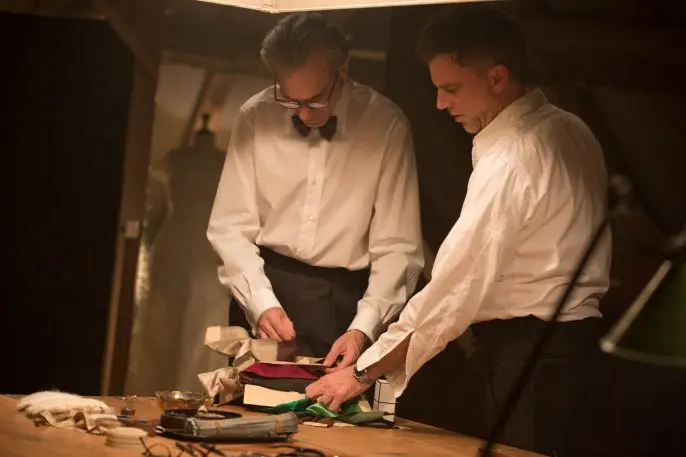
“There’s a quality or inventiveness for Reynolds Woodcock where we decided that he wasn’t gonna be the most groundbreaking designer in the world,” says costume designer Mark Bridges. “He wasn’t gonna be a Balenciaga or a Dior. Rather, he’s gonna fit into that world of London couture at the time, which was quite, quite active and thriving. We decided Reynolds would go down in history, with the names like Victor Stiebel or Michael Sherard. And you get a sense of who he is from the dresses he makes.”
Bridges, an Academy Award-winner for The Artist, nominated again just this week for Phantom Thread, has been working with Paul Thomas Anderson for 22 years. They collaborated on Anderson’s debut feature, Hard Eight, and have re-teamed on each of the auteur’s films ever since. By now, the two have forged a rhythm and a shorthand–the ideas flow freely in both directions–that makes working together feel natural.
The costume work begins during the writing phase. As Anderson gets further along in his script, he sends pieces of it over to Bridges for inspiration. Bridges might receive five separate versions of the script during this period, but even the differences in drafts help him figure out how to bring the ideas to life.
“We work about a year and a half before shooting together,” Bridges says. “He’ll call me up and say like ‘Such-and-such is on Turner Classic Movies, turn it on.’ And I’ll be like, ‘I’m already watching it.’ We’re kind of simpatico like that.”
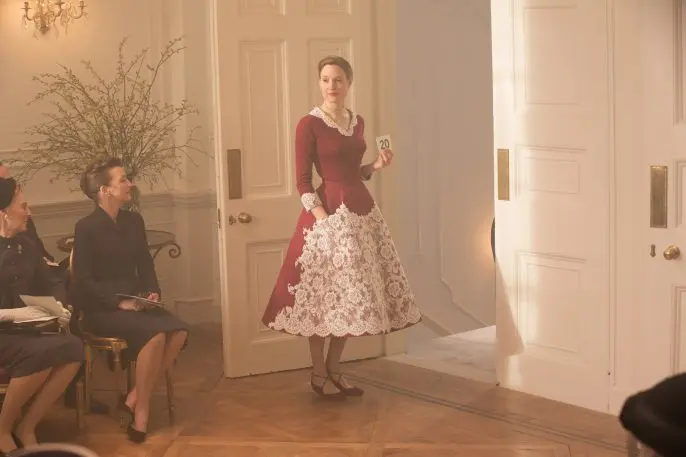
The clothing in Phantom Thread involved a new set of challenges, though. Reynolds Woodcock is a dressmaker of world renown, with impeccable taste. The quality of the clothes he creates helps define him, and what other people are wearing help define them in opposition to him. This kind of quality is difficult to fake, and it’s not the kind of special effect that typically gets CGI’d. Instead, Bridges and his team had to make the dresses depicted on-screen in the way that Reynolds Woodcock would have made them.
They performed research at the Victoria and Albert Museum of Art and Design in London, taking a private viewing of couture gowns from the 1950s. They observed the handiwork that went into these outfits–the way the skirts were flatlined with organza, for instance, and the way that some of the foundations were put into the dresses–and they tried to follow the blueprint as much as possible. In the end, the gowns they created would only work as still life pieces–being believable in the movie, but not functional in real life. However, they more than accomplish the job of selling Reynolds Woodcock as a master craftsman.
Read on below, as Mark Bridges describes how he, Anderson, and Daniel Day-Lewis arrived at some specific garments from the film.
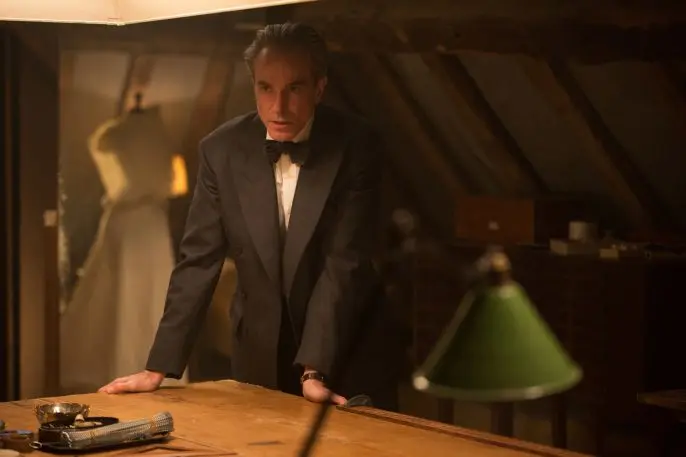
“The ties Woodcock wears are both common to the era and an affectation of his. They’re vaguely based on the shape of the Turnbull & Asser necktie but I think it’s the beautiful way that Daniel [Day-Lewis] tied them that makes them luscious. We found a lot of vintage necktie fabric and he chose what he liked and we made those. They were common at the time but I think it’s kind of smart with someone who has sort of a long-lean frame and a long face to break it there in a horizontal. We camera-tested long and for a while we were gonna go with them, but ultimately the bowties won.

“Daniel [Day-Lewis] weighed in a lot about the clothes his character would wear, but since his character is a couturier, we included him into the fittings of other characters too when his schedule allowed. I would have him choose colors for some of the House of Woodcock re-creations. There was a sense of authorship for his character on some of these things. I think it was a really important part for him of being that character. And it was fine with me. He has wonderful taste and made great choices as the character.”
Alma’s First Date Dress
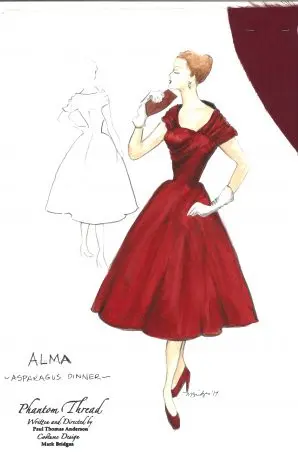
“When Alma and Reynolds first go out together, she’s wearing this red dress. That is a real vintage dress. I had found two of them in two different colors. And Alma has a sister and so there was kind of this backstory, like, home sewing–they each made one. We originally had scenes with Alma and her sister, and also had Alma coming downstairs and her family seeing her as she’s going out with Reynolds, and the brother comments, like, ‘A bit bright, isn’t it?’ And she’s like, ‘It’s meant to be.’ Even without that dialogue, though, you notice that dress as a kind of odd, homespun, unsophisticated dress but kind of a bold choice for the first meeting with this man. So I think it indicates that there is some kind of big move into the whole situation, even without talking about it like that.”
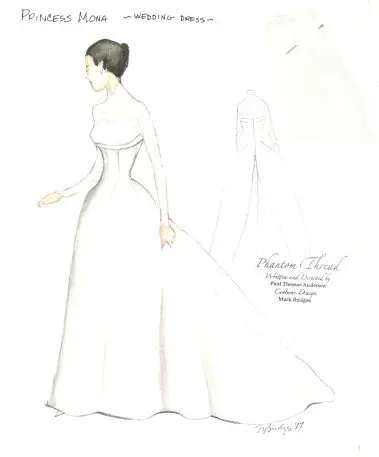
“I think the design of this dress is meant to indicate that there is a problem there. He set the bar really high with his discussion with Princess Mona. And shortly after that, when he talks to his sister about how since Alma’s come in this house, he can’t work. I think this dress is the first hint there is something awry. We designed it with, like, riffing on some other shape that we saw in a black lace dress that she wears on top. And it’s kind of a heavy, stiff skirt. There are aspects to it that are kind of awkward. I think it’s good that it’s not the most delicious dress in the world because it speaks volumes about him, what’s going on there, and how sometimes the best laid plans don’t come out.”
Recognize your brand’s excellence by applying to this year’s Brands That Matter Awards before the early-rate deadline, May 3.
